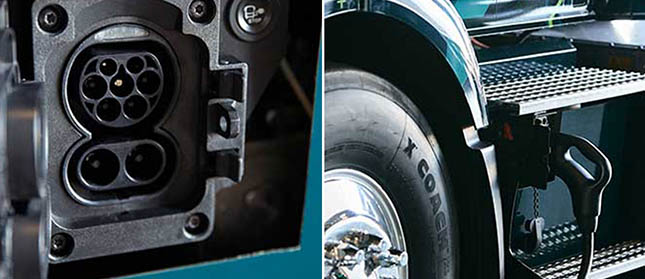
Canada’s ambitious timelines to decarbonize the nation’s medium- and heavy-duty trucks is achievable, but will require the fast deployment of charging infrastructure and much more investment than has been allocated to date, reports Today’s Trucking.
Citing a report from the Pembina Institute, titled Zero-emission MHDVs in Canada and required charging infrastructure, Today’s Trucking points out that experts recognize the need to decarbonize the goods transport sector, but the federal government’s investment in providing electric charging infrastructure for medium- and heavy-duty trucks lags what’s needed.
The Pembina Institute says that to date, the feds have committed only $1 billion of the $5 billion needed to support the anticipated number of electric trucks on the road by 2030.
Pembina modeling suggests that by 2030, the segment will require: 70,000 Level 2 private depot chargers, increasing to 450,000 by 2050; 6,500 Level 3 public chargers by 2030, increasing to 50,000 by 2050; and 2,000 hydrogen fueling stations by 2030, increasing to 30,000 in 2050.
Adam Thorn, director of the Pembina Institute’s transportation program and an author of the report, told James Menzies of TT that he thinks it’s possible to achieve,
“I absolutely do think they are doable,” he said of the federal government’s timelines, calling for 35% of new medium- and heavy-duty truck sales to be zero emissions by 2030, and 100% by 2040. “But I think they have to be done in a very smart way. We’re advocating for a phased-in approach. We need to focus on those areas in which we have some low-hanging fruit.”
This means focusing initially on applications that are easy to electrify today, such as smaller delivery vehicles with predictable routes and frequent returns to the home depot for charging.
“They’re ready to go now,” Thorn said of these vehicles, mainly in the Classes 2B to 5 categories. “They tend to have relatively short, predictable routes. They return to the barn at the end of the day so there’s lots of opportunities there for that charging. By focusing on those vehicles that are ready to go, we think we can move very quickly.”
Charging infrastructure for those vehicles will primarily be installed at depots, but the report suggests the federal government assist in funding that infrastructure and not expect industry to bear the entire cost.
“One of our recommendations was to carve out a specific piece of the Zero Emission Vehicle Infrastructure Program for those types of vehicles, and depot charging specifically,” Thorn said. “Then what we’re hoping is the learnings, the innovation, the technology development in those segments will trickle up to those heavier categories.”
When deploying public charging stations for trucks, the Pembina report suggests focusing initially on freight corridors, such as Toronto-Montreal.
“We can focus on those areas in which there’s a lot of trucking,” reasoned Thorn.
The report recommends installing at least one charging and hydrogen refueling station every 60 km along key sections of the Trans-Canada Highway and the Ontario-Quebec Continental Gateway by 2030. The distance between hydrogen refueling stations should be less than 150 km, the report suggests, with each having capacity greater than 2 tonnes/day.
There are also questions as to whether the electric grids in Canada can support the widespread electrification of medium and heavy trucks.
While government funding will play a significant role if the trucking industry is to meet the federal government’s timelines, fleets too will need to invest. And those investments will be sizeable.
“I understand their reluctance. Many small fleets simply don’t have the capacity for this. So, we’re seeing the large fleets … to do this because they can take on some of that risk and they have that capacity. As those big fleets begin to roll out, we’re going to see this industry mature. We’re going to see it in more vehicles and technology is going to develop. We’re going to see more infrastructure. I think taking a longer view is something we need to do.”
The full report can be viewed here.
The full Today’s Trucking article can be viewed here.
Relatedly, a new study by Uber Freight also calls for increased support of charging infrastructure, finding that local hauls in large urban markets are the best candidates to serve as the starting point for the deployment of an eventual nationwide charging network.
Uber Freight suggested that starting with local hauls is a good first step toward electrification due to the limitations of today’s charging infrastructure.
Highlights from the report includes:
- In local markets, if charging stations are located strategically, only a few stations are needed in each market to accelerate electric truck adoption.
- Markets like Los Angeles, Ontario, Atlanta, Dallas, and New York are strong early candidates. For example, in Dallas / Fort Worth, 10 charging stations are enough to provide early adopters with access to most local loads, accounting for 95% of local freight miles.
- Optimizing truck charger locations remains a complex task with many variables, including shippers’ locations, grid readiness, throughput time-of-day, locations of truck depots, and land availability.
- Although they account for a quarter of all freight loads in the U.S., local hauls (those less than 150 miles) account for a small fraction (3.2%) of the miles traveled. Therefore, electrifying the interstate system, which carries more than half of all trucking miles, is critical to achieving a meaningful reduction in freight emissions.
